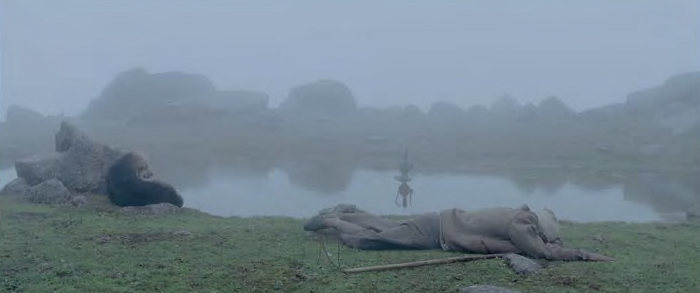‘What forced the shepherd with thousands of goats, cows and dogs the size of bears, to walk the sacred Naga mountain?’, ask the Gaddi shepherds. Ridham Janve’s film is set in the difficult pastoral hills of Himachal, amongst the shepherds of Gaddi community, who revere Naga-devta, and maintain that only those with the purest of intentions and immense experience can tread the Naga mountain.

Arjun, an ageing shepherd, complaints to his young protege/caretaker Bahadur about his body aches, lack of water and Bahadur’s general incompetence. Bahadur tells tales of long lost riches, hidden in the mountains and crashed planes full of precious rubble, while the elderly shepherds tell about the lost prosperous shepherd.
Vast panoramas of the pastoral hills touching the clouds define the environment of the film – the hills often feature sheep grazing, shot from considerable heights. I get the feeling of how difficult the process of capturing the image itself would have been. Sheep often look like dots bending in and out like streams of water, and the shepherds often enter and exist landscapes similarly, as if visually implying the (in)significance of humans in front of nature itself.
When an Air Force jet crashes on the sacred mountain, Arjun decides to search for it. He neither prefers tea nor cold-drinks, or the monetary rewards either, proclaims Arjun to shop-owner who informs him of the prize before he begins the search.
An inebriated and frustrated Bahadur, tries to trace the path Arjun followed, only to disastrously pass out on the way. Gold-laden sheep pass by him, imagines Arjun, discovered by people passing-by. Unlike Bahadur, whose greed made the better of him, Arjun keeps walking, only to discover other people in search too, and reaches a land of almost mythical qualities. The filmmakers employ surreal imagery to invite us to read into mystery of the disappearances. Arjun stands beside the lake, watching his own reflection, invoking the tale of Narcissus. Arjun can now have all the water he wants, as he gets surrounded with waterfalls around.
A minimal but sweeping score is used sparingly, to convey a sense of grandeur and divinity of the mountains. There are rules here ingrained in nature, which humans follow only after accepting their own stature against nature. But the sweeping shots, and the braying sheep demand a certain amount of patience from the audience; the human characters are barely lit enough to be seen, and conversations happen sparingly, the characters often addressing the sheep when lonely.

The film blends the fiction and folklores into reality, as characters practically walking down entire mountains onscreen in their quest. If one accepts the excesses of the style (which, in a sense arrives from the filmmaker’s perceived reverence to the subjects and the place itself), one can see, it was pride, more than greed, that destroyed the prosperous shepherd; it is pride that makes Arjun wander, pride in his own capabilities and experience.
